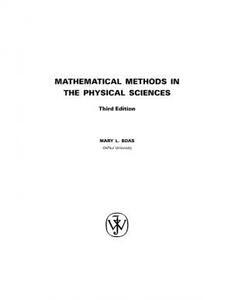
Mathematical Methods in the Physical Sciences 3rd Edition PDF
Preview Mathematical Methods in the Physical Sciences 3rd Edition
MATHEMATICAL METHODS IN THE PHYSICAL SCIENCES Third Edition MARY L. BOAS DePaulUniversity MATHEMATICAL METHODS IN THE PHYSICAL SCIENCES MATHEMATICAL METHODS IN THE PHYSICAL SCIENCES Third Edition MARY L. BOAS DePaulUniversity PUBLISHER KayePace SENIORACQUISITIONSEditor StuartJohnson PRODUCTIONMANAGER PamKennedy PRODUCTIONEDITOR SarahWolfman-Robichaud MARKETINGMANAGER AmandaWygal SENIORDESIGNER DawnStanley EDITORIALASSISTANT KristaJarmas/AlysonRentrop PRODUCTIONMANAGER JanFisher/PublicationServices Thisbookwassetin10/12ComputerModernbyPublicationServicesandprintedandboundby R.R.Donnelley-Willard. ThecoverwasprintedbyLehighPress. Thisbookisprintedonacidfreepaper. Copyright2006JohnWiley&Sons,Inc. Allrightsreserved. Nopartofthispublicationmay bereproduced,storedinaretrievalsystemortransmittedinanyformorbyanymeans, electronic,mechanical,photocopying, recording,scanning,orotherwise,except aspermitted underSections 107or108ofthe1976UnitedStates CopyrightAct,withouteithertheprior writtenpermissionofthePublisher,orauthorization throughpaymentoftheappropriate per-copyfeetotheCopyrightClearanceCenter,Inc.,222RosewoodDrive,Danvers,MA01923, (978)750-8400, fax(978)750-4470 oronthewebatwww.copyright.com. Requests tothe PublisherforpermissionshouldbeaddressedtothePermissionsDepartment,JohnWiley& Sons,Inc.,111RiverStreet,Hoboken, NJ07030-5774, (201)748-6011, fax(201)748-6008, or onlineathttp://www.wiley.com/go/permissions. Toorderbooksorforcustomer serviceplease,call1-800-CALLWILEY (225-5945). ISBN0-471-19826-9 ISBN-13978-0-471-19826-0 ISBN-WIE0-471-36580-7 ISBN-WIE-13978-0-471-36580-8 PrintedintheUnitedStates ofAmerica 10987654321 To the memory of RPB PREFACE Thisbookisparticularlyintendedforthestudentwithayear(orayearandahalf) ofcalculuswhowantstodevelop,inashorttime, abasiccompetenceineachofthe many areas of mathematics needed in junior to senior-graduate courses in physics, chemistry, and engineering. Thus it is intended to be accessible to sophomores (or freshmen with AP calculus from high school). It may also be used effectively by a more advanced student to review half-forgotten topics or learn new ones, either by independent study or in a class. Although the book was written especially for students of the physical sciences, students in any field (say mathematics or mathematics for teaching) may find it useful to survey many topics or to obtain some knowledge of areas they do not have time to study in depth. Since theorems arestatedcarefully,suchstudentsshouldnotneedtounlearnanythingintheirlater work. The question of proper mathematical training for students in the physical sci- encesisofconcerntobothmathematiciansandthosewhousemathematicsinappli- cations. Some instructorsmay feel that if students are goingto study mathematics at all, they should study it in careful and thorough detail. For the undergradu- ate physics, chemistry, or engineering student, this means either (1) learning more mathematics thana mathematics majoror(2) learninga few areasofmathematics thoroughly and the others only from snatches in science courses. The second alter- native is often advocated; let me say why I think it is unsatisfactory. It is certainly true that motivation is increased by the immediate application of a mathematical technique, but there are a number of disadvantages: 1. The discussion of the mathematics is apt to be sketchy since that is not the primary concern. 2. Students are faced simultaneously with learning a new mathematical method and applying it to an area of science that is also new to them. Frequently the vii viii Preface difficulty in comprehending the new scientific area lies more in the distraction causedbypoorlyunderstoodmathematicsthanitdoesinthenewscientificideas. 3. Students may meet what is actually the same mathematical principle in two different science courses without recognizing the connection, or even learn ap- parently contradictory theorems in the two courses! For example, in thermody- namics students learn that the integral of an exact differential ar(cid:1)ound a closed pathisalwayszero. Inelectricityorhydrodynamics,theyruninto 2π dθ,which 0 is certainly the integral of an exact differential around a closed path but is not equal to zero! Nowitwouldbefineifeverysciencestudentcouldtaketheseparatemathematics courses in differential equations (ordinary and partial), advanced calculus, linear algebra, vector and tensor analysis, complex variables, Fourier series, probability, calculus of variations,specialfunctions, and so on. However,most science students haveneitherthetime northeinclinationtostudythatmuchmathematics,yetthey are constantly hampered in their science courses for lack of the basic techniques of thesesubjects. Itistheintentofthisbooktogivethesestudentsenoughbackground in each of the needed areas so that they can cope successfully with junior, senior, and beginning graduate courses in the physical sciences. I hope, also, that some students will be sufficiently intrigued by one or more of the fields of mathematics to pursue it futher. Itisclearthatsomethingmustbeomittedifsomanytopicsaretobecompressed into one course. I believe that two things can be left out without serious harm at this stage of a student’s work: generality, and detailed proofs. Stating and proving a theorem in its most general form is important to the mathematician and to the advanced student, but it is often unnecessary and may be confusing to the more elementary student. This is not in the least to say that science students have no use forcarefulmathematics. Scientists,evenmorethan puremathematicians, need careful statements of the limits of applicability of mathematical processes so that they canuse them with confidence without having to supply proofof their validity. ConsequentlyIhaveendeavoredtogiveaccuratestatementsoftheneededtheorems, althoughoftenforspecialcasesorwithoutproof. Interestedstudentscaneasilyfind more detail in textbooks in the special fields. Mathematical physics texts at the senior-graduate level are able to assume a degree of mathematical sophistication and knowledge of advanced physics not yet attainedby students atthe sophomorelevel. Yet suchstudents, ifgivensimple and clear explanations, can readily master the techniques we cover in this text. (They not only can, but will have to in one way or another, if they are going to pass their junior and senior physics courses!) These students are not ready for detailed applications—these they will get in their science courses—but they do need and want to be given some idea of the use of the methods they are studying, and some simple applications. This I have tried to do for each new topic. For those of youfamiliar with the secondedition, let me outline the changesfor the third: 1. Prompted by several requests for matrix diagonalization in Chapter 3, I have moved the first part of Chapter 10 to Chapter 3 and then have amplified the treatment of tensors in Chapter 10. I have also changed Chapter 3 to include moredetailaboutlinearvectorspacesandthenhavecontinuedthe discussionof basis functions in Chapter 7 (Fourier series), Chapter 8 (Differential equations),
